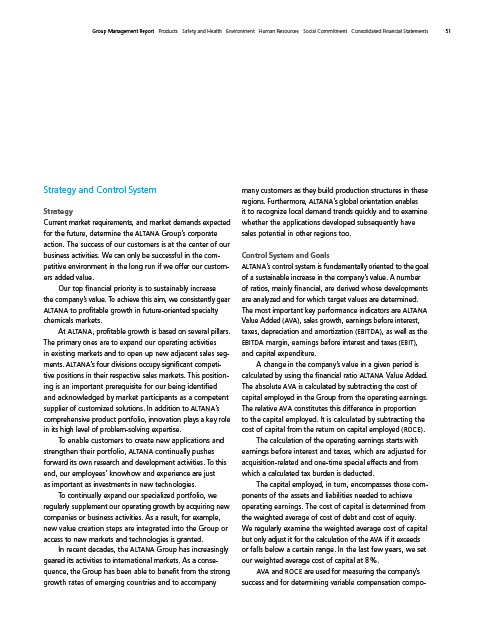
Management Report Products Safety and Health Environment Human Resources Social Commitment Consolidated Financial Statements 51
Strategy and Control System
Strategy
Current market requirements, and market demands expected
for the future, determine the ALTANA
Group’s corporate
action. The success of our customers is at the center of our
business activities. We can only be successful in the competitive
environment in the long run if we offer our customers
added value.
Our top financial priority is to sustainably increase
the company’s value. To achieve this aim, we consistently gear
ALTANA
to profitable growth in future-oriented specialty
chemicals markets.
At ALTANA,
profitable growth is based on several pillars.
The primary ones are to expand our operating activities
in existing markets and to open up new adjacent sales segments.
ALTANA’s
four divisions occupy significant competi
tive positions in their respective sales markets. This positioning
is an important prerequisite for our being identified
and acknowledged by market participants as a competent
supplier of customized solutions. In addition to ALTANA’s
comprehensive product portfolio, innovation plays a key role
in its high level of problem-solving expertise.
To enable customers to create new applications and
strengthen their portfolio, ALTANA
continually pushes
forward its own research and development activities. To this
end, our employees’ knowhow and experience are just
as important as investments in new technologies.
To continually expand our specialized portfolio, we
regularly supplement our operating growth by acquiring new
companies or business activities. As a result, for example,
new value creation steps are integrated into the Group or
access to new markets and technologies is granted.
In recent decades, the ALTANA
Group has increasingly
geared its activities to international markets. As a consequence,
the Group has been able to benefit from the strong
growth rates of emerging countries and to accompany
many customers as they build production structures in these
regions. Furthermore, ALTANA’s
global orientation enables
it to recognize local demand trends quickly and to examine
whether the applications developed subsequently have
sales potential in other regions too.
Control System and Goals
ALTANA’s
control system is fundamentally oriented to the goal
of a sustainable increase in the company’s value. A number
of ratios, mainly financial, are derived whose developments
are analyzed and for which target values are determined.
The most important key performance indicators are ALTANA
Value Added (AVA), sales growth, earnings before interest,
taxes, depreciation and amortization (EBITDA), as well as the
EBITDA margin, earnings before interest and taxes (EBIT),
and capital expenditure.
A change in the company’s value in a given period is
calculated by using the financial ratio ALTANA
Value Added.
The absolute AVA is calculated by subtracting the cost of
capital employed in the Group from the operating earnings.
The relative AVA constitutes this difference in proportion
to the capital employed. It is calculated by subtracting the
cost of capital from the return on capital employed (ROCE).
The calculation of the operating earnings starts with
earnings before interest and taxes, which are adjusted for
acquisition-related and one-time special effects and from
which a calculated tax burden is deducted.
The capital employed, in turn, encompasses those components
of the assets and liabilities needed to achieve
operating earnings. The cost of capital is determined from
the weighted average of cost of debt and cost of equity.
We regularly examine the weighted average cost of capital
but only adjust it for the calculation of the AVA if it exceeds
or falls below a certain range. In the last few years, we set
our weighted average cost of capital at 8 %.
AVA and ROCE are used for measuring the company’s
success and for determining variable compensation compoGroup